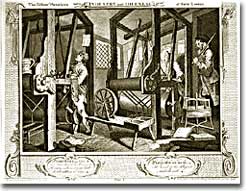


This picture, Industry and Idleness, shows 2 apprentices starting in identical circumstances, one is the industrious Francis Goodchild and the other is the unsuccessful Thomas Idlefrom.
The growth of tobacco, rice, and indigo and the plantation economy created a tremendous need for labor in Southern English America. Without the aid of modern machinery, human sweat and blood was necessary for the planting, cultivation, and harvesting of these cash crops. While slaves existed in the English colonies throughout the 1600s, indentured servitude was the method of choice employed by many planters before the 1680s. This system provided incentives for both the master and servant to increase the working population of the Chesapeake colonies.
Virginia and Maryland operated under what was known as the " headright system ." The leaders of each colony knew that labor was essential for economic survival, so they provided incentives for planters to import workers. For each laborer brought across the Atlantic, the master was rewarded with 50 acres of land. This system was used by wealthy plantation aristocrats to increase their land holdings dramatically. In addition, of course, they received the services of the workers for the duration of the indenture.
This system seemed to benefit the servant as well. Each indentured servant would have their fare across the Atlantic paid in full by their master. A contract was written that stipulated the length of service — typically five years. The servant would be supplied room and board while working in the master's fields. Upon completion of the contract, the servant would receive "freedom dues," a pre-arranged termination bonus. This might include land, money, a gun, clothes or food. On the surface it seemed like a terrific way for the luckless English poor to make their way to prosperity in a new land. Beneath the surface, this was not often the case.
Only about 40 percent of indentured servants lived to complete the terms of their contracts. Female servants were often the subject of harassment from their masters. A woman who became pregnant while a servant often had years tacked on to the end of her service time. Early in the century, some servants were able to gain their own land as free men. But by 1660, much of the best land was claimed by the large land owners. The former servants were pushed westward, where the mountainous land was less arable and the threat from Indians constant. A class of angry, impoverished pioneer farmers began to emerge as the 1600s grew old. After Bacon's Rebellion in 1676, planters began to prefer permanent African slavery to the headright system that had previously enabled them to prosper.

Apprentices of Indentures; Delaware County, New York
It's hard to believe, but the practice of indentured servitude in American did not end in the United States until the early 1900s. This site lists the contract terms between Masters and Servants in one New York County.
Gottlieb Mittelberger: On the Misfortune of Indentured Servants (1754)
Life was dreadful for Indentured Servants even before they started working. Gottlieb Mittelberger of the Netherlands describes the situation of indentured servants coming from his country, the Netherlands, to America. A sickening slice of what you'll find: "But during the voyage there is on board these ships terrible misery, stench, fumes, horror, vomiting, many kinds of sea-sickness, fever, dysentery, headache, heat, constipation, boils, scurvy, cancer, mouth-rot, and the like, all of which come from old and sharply salted food and meat, also from very bad and foul water, so that many die miserably." Next time you're tempted to say your folks treat you like a slave, think of this page.
Indentured Servants and Transported Convicts
A page which briefly explores the lives of indentured servants at Stratford Hall, the birthplace of Robert E. Lee. Some interesting factoids to be found here.
Virtual Jamestown: Indentured Servants
Links to 17th-century legal documents which address such topics as "First recorded case of master-servant dispute" and "Laws clearly defining the differences between servant and slave." Primary source documents can't be beat.
The misery reaches the climax when a gale rages for 2 or 3 nights and days, so that every one believes that the ship will go to the bottom with all human beings on board. In such a visitation the people cry and pray most piteously. -Gottlieb Mittelberger, On the Misfortune of Indentured Servants , 1754
Learn More.